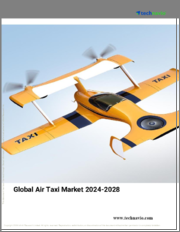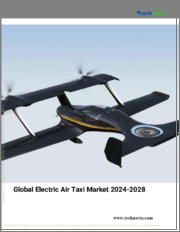
|
시장보고서
상품코드
1665989
에어 택시 시장 규모, 점유율, 성장 분석 : 운행 범위별, 운행 모드별, 유형별, 지역별 - 산업 예측(2025-2032년)Air Taxi Market Size, Share, and Growth Analysis, By Range (Intercity (100 Kilometers To 400 Kilometers), Intracity (20 Kilometers To 100 Kilometers)), By Mode Of Operation (Optionally Piloted, Piloted), By Type, By Region - Industry Forecast 2025-2032 |
||||||
에어 택시 시장 규모는 2023년 13억 8,000만 달러로 평가되며, 2024년 18억 달러에서 2032년 150억 4,000만 달러로 예측 기간(2025-2032년) 동안 30.4%의 CAGR로 성장할 것으로 예상됩니다.
에어 택시 시장은 도시 교통의 재편을 약속하는 혁신적 트렌드에 힘입어 빠르게 진화하고 있습니다. 주요 발전은 전기 수직이착륙(eVTOL) 항공기에 대한 관심과 투자가 증가하고 있으며, eVTOL 항공기는 전기 파워트레인의 발전으로 도시 이동을 위한 더 깨끗하고 조용한 대안을 제공하고 있습니다. 이러한 성장은 소음 공해와 화석 연료 배출에 대한 우려를 해결하기 위해 지속가능한 항공 솔루션으로 전환하는 전 세계적인 변화를 반영합니다. 또한, 기존 항공사와 함께 수많은 스타트업이 등장하여 경쟁과 혁신을 촉진하고 있습니다. 전통적인 항공사와 기술 기업의 협업은 점점 더 보편화되어 에어 택시의 상용화를 가속화하고 있습니다. 또한, 인공지능과 첨단 센서로 강화된 자율 비행 기술의 통합은 이러한 발전에 대응하기 위해 규제가 진화함에 따라 완전히 자율적인 에어 택시 서비스의 미래로 가는 길을 열어주고 있습니다.
목차
소개
- 조사 목적
- 조사 범위
- 정의
조사 방법
- 정보 조달
- 2차와 1차 데이터 방법
- 시장 규모 예측
- 시장 가정과 제한
주요 요약
- 세계 시장 전망
- 공급과 수요 동향 분석
- 부문별 기회 분석
시장 역학과 전망
- 시장 개요
- 시장 규모
- 시장 역학
- 성장 촉진요인과 기회
- 성장 억제요인과 과제
- Porters 분석
주요 시장 인사이트
- 핵심성공요인
- 경쟁 정도
- 주요 투자 기회
- 시장 생태계
- 시장 매력 지수(2024년)
- PESTEL 분석
- 거시경제 지표
- 밸류체인 분석
- 가격 분석
에어 택시 시장 규모 : 운행 범위별 & CAGR(2025-2032년)
- 시장 개요
- 도시간(100 KM-400 KM)
- 시내(20 KM-100 KM)
에어 택시 시장 규모 : 운행 모드별 & CAGR(2025-2032년)
- 시장 개요
- 유인 조종 옵션
- 파일럿
에어 택시 시장 규모 : 유형별 & CAGR(2025-2032년)
- 시장 개요
- 에어 택시 플랫폼 서비스
- 에어 택시 Mro 서비스
- 에어 택시 파일럿 트레이닝 서비스
에어 택시 시장 규모 : 지역별 & CAGR(2025-2032년)
- 북미
- 미국
- 캐나다
- 유럽
- 독일
- 스페인
- 프랑스
- 영국
- 이탈리아
- 기타 유럽
- 아시아태평양
- 중국
- 인도
- 일본
- 한국
- 기타 아시아태평양
- 라틴아메리카
- 브라질
- 기타 라틴아메리카
- 중동 및 아프리카
- GCC 국가
- 남아프리카공화국
- 기타 중동 및 아프리카
경쟁 정보
- 상위 5개사의 비교
- 주요 기업의 시장 포지셔닝(2024년)
- 주요 시장 기업이 채용한 전략
- 최근의 시장 동향
- 기업의 시장 점유율 분석(2024년)
- 주요 기업 개요
- 기업 상세
- 제품 포트폴리오 분석
- 기업 부문별 점유율 분석
- 매출 전년비 비교(2022-2024년)
주요 기업 개요
- Joby Aviation(United States)
- Archer Aviation(United States)
- EHang(China)
- Volocopter GmbH(Germany)
- Lilium GmbH(Germany)
- Vertical Aerospace(United Kingdom)
- Wisk Aero LLC(United States)
- Eve Air Mobility(Brazil)
- Supernal(United States)
- Overair(United States)
- Airbus SE(Netherlands)
- The Boeing Company(United States)
- Textron Inc.(United States)
- Hyundai Motor Company(South Korea)
- Embraer S.A.(Brazil)
- Beta Technologies Inc.(United States)
- Jaunt Air Mobility LLC(United States)
- Skyports AeroSystems Ltd.(United Kingdom)
- Neva Aerospace Ltd.(United Kingdom)
- Zeva Aero Inc.(United States)
결론과 제안
ksm 25.04.03Air Taxi Market size was valued at USD 1.38 billion in 2023 and is poised to grow from USD 1.8 billion in 2024 to USD 15.04 billion by 2032, growing at a CAGR of 30.4% during the forecast period (2025-2032).
The air taxi market is rapidly evolving, driven by transformative trends that promise to reshape urban transportation. A key development is the rising interest and investment in electric vertical takeoff and landing (eVTOL) aircraft, which offer cleaner, quieter alternatives for city travel thanks to advancements in electric powertrains. This growth reflects a global shift towards sustainable aviation solutions, addressing concerns about noise pollution and fossil fuel emissions. Furthermore, the emergence of numerous startups alongside established aviation companies is fueling competition and innovation. Collaborations between traditional aviation and technology firms are increasingly common, accelerating the commercialization of air taxis. Additionally, the integration of autonomous flight technology, enhanced by artificial intelligence and advanced sensors, is paving the way for a future with fully autonomous air taxi services as regulations evolve to accommodate these advancements.
Top-down and bottom-up approaches were used to estimate and validate the size of the Air Taxi market and to estimate the size of various other dependent submarkets. The research methodology used to estimate the market size includes the following details: The key players in the market were identified through secondary research, and their market shares in the respective regions were determined through primary and secondary research. This entire procedure includes the study of the annual and financial reports of the top market players and extensive interviews for key insights from industry leaders such as CEOs, VPs, directors, and marketing executives. All percentage shares split, and breakdowns were determined using secondary sources and verified through Primary sources. All possible parameters that affect the markets covered in this research study have been accounted for, viewed in extensive detail, verified through primary research, and analyzed to get the final quantitative and qualitative data.
Air Taxi Market Segments Analysis
Global Air Taxi Market is segmented by Range, Mode Of Operation, Type and region. Based on Range, the market is segmented into Intercity (100 Kilometers To 400 Kilometers) and Intracity (20 Kilometers To 100 Kilometers). Based on Mode Of Operation, the market is segmented into Optionally Piloted and Piloted. Based on Type, the market is segmented into Air Taxi Platform Services, Air Taxi Mro Services and Air Taxi Pilot Training Services. Based on region, the market is segmented into North America, Europe, Asia Pacific, Latin America and Middle East & Africa.
Driver of the Air Taxi Market
The global air taxi market is experiencing significant growth, fueled by rising investments from both private entities and government sectors, in addition to the formation of strategic partnerships. Major aerospace corporations, technology startups, and venture capitalists are investing substantial resources into the advancement of air taxi technologies. This influx of funding is not only driving innovation at an accelerated pace but also simplifying the entry process into the market, paving the way for the realization of air taxis as a feasible transportation option. Such developments indicate a promising future for urban air mobility solutions.
Restraints in the Air Taxi Market
One significant obstacle facing the air taxi market is the lack of appropriate infrastructure, including vertiports, charging stations, and maintenance facilities. The development of these essential hubs requires substantial financial investments and strong cooperation between public and private sectors. Without this specialized infrastructure in place, the widespread acceptance and adoption of air taxis may not be achievable. Therefore, addressing this critical gap is vital for the growth and success of the air taxi industry, as such facilities are integral to creating a viable ecosystem for urban air mobility solutions in the future.
Market Trends of the Air Taxi Market
The air taxi market is witnessing a significant shift towards electric propulsion systems, driven by advancements in electric vertical takeoff and landing (eVTOL) aircraft. Major players are prioritizing the development of high-performance electric engines that not only enhance operational efficiency but also support the transition to zero-emission vehicles. This trend is fueled by growing environmental concerns and the demand for sustainable urban transport solutions. As cities increasingly seek cleaner air travel options, the focus on electric mobility is anticipated to reduce operational costs and minimize environmental footprints, positioning electric air taxis as a pivotal innovation in the future of urban transportation.
Table of Contents
Introduction
- Objectives of the Study
- Scope of the Report
- Definitions
Research Methodology
- Information Procurement
- Secondary & Primary Data Methods
- Market Size Estimation
- Market Assumptions & Limitations
Executive Summary
- Global Market Outlook
- Supply & Demand Trend Analysis
- Segmental Opportunity Analysis
Market Dynamics & Outlook
- Market Overview
- Market Size
- Market Dynamics
- Drivers & Opportunities
- Restraints & Challenges
- Porters Analysis
- Competitive rivalry
- Threat of substitute
- Bargaining power of buyers
- Threat of new entrants
- Bargaining power of suppliers
Key Market Insights
- Key Success Factors
- Degree of Competition
- Top Investment Pockets
- Market Ecosystem
- Market Attractiveness Index, 2024
- PESTEL Analysis
- Macro-Economic Indicators
- Value Chain Analysis
- Pricing Analysis
Global Air Taxi Market Size by Range & CAGR (2025-2032)
- Market Overview
- Intercity (100 Kilometers To 400 Kilometers)
- Intracity (20 Kilometers To 100 Kilometers)
Global Air Taxi Market Size by Mode Of Operation & CAGR (2025-2032)
- Market Overview
- Optionally Piloted
- Piloted
Global Air Taxi Market Size by Type & CAGR (2025-2032)
- Market Overview
- Air Taxi Platform Services
- Air Taxi Mro Services
- Air Taxi Pilot Training Services
Global Air Taxi Market Size & CAGR (2025-2032)
- North America (Range, Mode Of Operation, Type)
- US
- Canada
- Europe (Range, Mode Of Operation, Type)
- Germany
- Spain
- France
- UK
- Italy
- Rest of Europe
- Asia Pacific (Range, Mode Of Operation, Type)
- China
- India
- Japan
- South Korea
- Rest of Asia-Pacific
- Latin America (Range, Mode Of Operation, Type)
- Brazil
- Rest of Latin America
- Middle East & Africa (Range, Mode Of Operation, Type)
- GCC Countries
- South Africa
- Rest of Middle East & Africa
Competitive Intelligence
- Top 5 Player Comparison
- Market Positioning of Key Players, 2024
- Strategies Adopted by Key Market Players
- Recent Developments in the Market
- Company Market Share Analysis, 2024
- Company Profiles of All Key Players
- Company Details
- Product Portfolio Analysis
- Company's Segmental Share Analysis
- Revenue Y-O-Y Comparison (2022-2024)
Key Company Profiles
- Joby Aviation (United States)
- Company Overview
- Business Segment Overview
- Financial Updates
- Key Developments
- Archer Aviation (United States)
- Company Overview
- Business Segment Overview
- Financial Updates
- Key Developments
- EHang (China)
- Company Overview
- Business Segment Overview
- Financial Updates
- Key Developments
- Volocopter GmbH (Germany)
- Company Overview
- Business Segment Overview
- Financial Updates
- Key Developments
- Lilium GmbH (Germany)
- Company Overview
- Business Segment Overview
- Financial Updates
- Key Developments
- Vertical Aerospace (United Kingdom)
- Company Overview
- Business Segment Overview
- Financial Updates
- Key Developments
- Wisk Aero LLC (United States)
- Company Overview
- Business Segment Overview
- Financial Updates
- Key Developments
- Eve Air Mobility (Brazil)
- Company Overview
- Business Segment Overview
- Financial Updates
- Key Developments
- Supernal (United States)
- Company Overview
- Business Segment Overview
- Financial Updates
- Key Developments
- Overair (United States)
- Company Overview
- Business Segment Overview
- Financial Updates
- Key Developments
- Airbus SE (Netherlands)
- Company Overview
- Business Segment Overview
- Financial Updates
- Key Developments
- The Boeing Company (United States)
- Company Overview
- Business Segment Overview
- Financial Updates
- Key Developments
- Textron Inc. (United States)
- Company Overview
- Business Segment Overview
- Financial Updates
- Key Developments
- Hyundai Motor Company (South Korea)
- Company Overview
- Business Segment Overview
- Financial Updates
- Key Developments
- Embraer S.A. (Brazil)
- Company Overview
- Business Segment Overview
- Financial Updates
- Key Developments
- Beta Technologies Inc. (United States)
- Company Overview
- Business Segment Overview
- Financial Updates
- Key Developments
- Jaunt Air Mobility LLC (United States)
- Company Overview
- Business Segment Overview
- Financial Updates
- Key Developments
- Skyports AeroSystems Ltd. (United Kingdom)
- Company Overview
- Business Segment Overview
- Financial Updates
- Key Developments
- Neva Aerospace Ltd. (United Kingdom)
- Company Overview
- Business Segment Overview
- Financial Updates
- Key Developments
- Zeva Aero Inc. (United States)
- Company Overview
- Business Segment Overview
- Financial Updates
- Key Developments



















